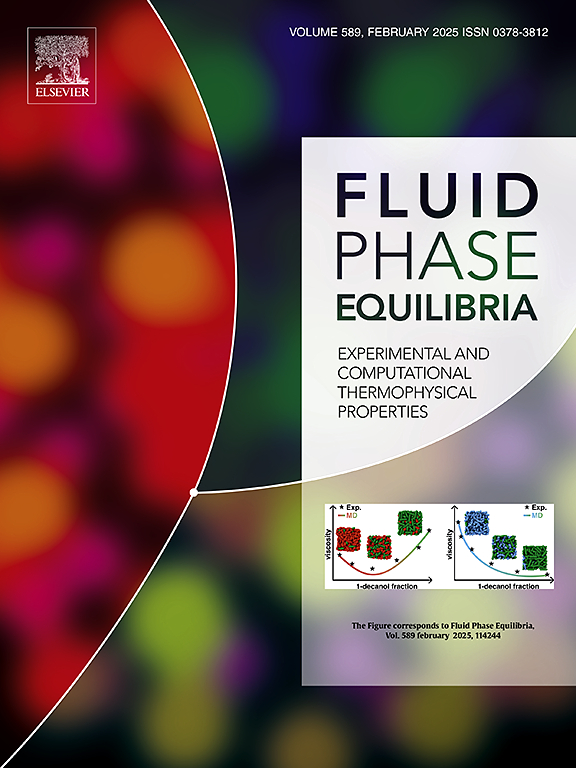Modeling polycyclic aromatic hydrocarbons (PAH) and liquid organic hydrogen carriers (LOHC) with the SAFT-γ Mie group-contribution equation of state
IF 2.7
3区 工程技术
Q3 CHEMISTRY, PHYSICAL
引用次数: 0
Abstract
Liquid organic hydrogen carriers (LOHC) are being studied as a promising and feasible alternative for hydrogen storage and transportation due to their high hydrogen uptake capacity, low flammability, and stability at ambient conditions. This work focuses on expanding the applications of the SAFT-γ Mie group-contribution equation of state by estimating the parameters of two new groups: an aromatic bridgehead carbon (aC), and a methylene “elbow” group connecting two aromatic rings (aCCH2aC), starting from readily available experimental data on polyaromatic hydrocarbons (PAH) and LOHC candidates such as alkylcarbazoles, diphenylmethane, and isomers of benzyltoluene and dibenzyltoluene. The model describes with good accuracy the vapor pressure and saturated liquid density of these substances, with a of 9.67 %, and a of 0.82 %, as well as the vapor-liquid equilibria of PAH + long-chain alkane mixtures, but has some limitations when describing the structural nuances of molecules that present the same functional groups. As a result, second-order interaction parameters are proposed to improve the correlation of the calculated and experimental data.
用SAFT-γ Mie基团贡献状态方程模拟多环芳烃(PAH)和液态有机氢载体(LOHC)
液态有机氢载体(LOHC)由于其高吸氢能力、低可燃性和在环境条件下的稳定性,正被研究作为一种有前途和可行的氢储存和运输替代方案。本工作的重点是通过估计两个新基团的参数来扩展SAFT-γ Mie基团贡献状态方程的应用:芳香桥头堡碳(aC)和连接两个芳香环的亚甲基“肘”基(aCCH2aC),从多芳烃(PAH)和LOHC候选物质如烷基咔唑、二苯基甲烷、苯甲苯和二苯甲苯的异构体的现有实验数据开始。该模型较准确地描述了这些物质的蒸汽压和饱和液体密度(%AADPvapoverall为9.67%,%AADρliqoverall为0.82%)以及多环芳烃+长链烷烃混合物的气液平衡,但在描述具有相同官能团的分子的结构差异时存在一定的局限性。为此,提出了二阶相互作用参数,以提高计算数据与实验数据的相关性。
本文章由计算机程序翻译,如有差异,请以英文原文为准。
求助全文
约1分钟内获得全文
求助全文
来源期刊

Fluid Phase Equilibria
工程技术-工程:化工
CiteScore
5.30
自引率
15.40%
发文量
223
审稿时长
53 days
期刊介绍:
Fluid Phase Equilibria publishes high-quality papers dealing with experimental, theoretical, and applied research related to equilibrium and transport properties of fluids, solids, and interfaces. Subjects of interest include physical/phase and chemical equilibria; equilibrium and nonequilibrium thermophysical properties; fundamental thermodynamic relations; and stability. The systems central to the journal include pure substances and mixtures of organic and inorganic materials, including polymers, biochemicals, and surfactants with sufficient characterization of composition and purity for the results to be reproduced. Alloys are of interest only when thermodynamic studies are included, purely material studies will not be considered. In all cases, authors are expected to provide physical or chemical interpretations of the results.
Experimental research can include measurements under all conditions of temperature, pressure, and composition, including critical and supercritical. Measurements are to be associated with systems and conditions of fundamental or applied interest, and may not be only a collection of routine data, such as physical property or solubility measurements at limited pressures and temperatures close to ambient, or surfactant studies focussed strictly on micellisation or micelle structure. Papers reporting common data must be accompanied by new physical insights and/or contemporary or new theory or techniques.
 求助内容:
求助内容: 应助结果提醒方式:
应助结果提醒方式:


